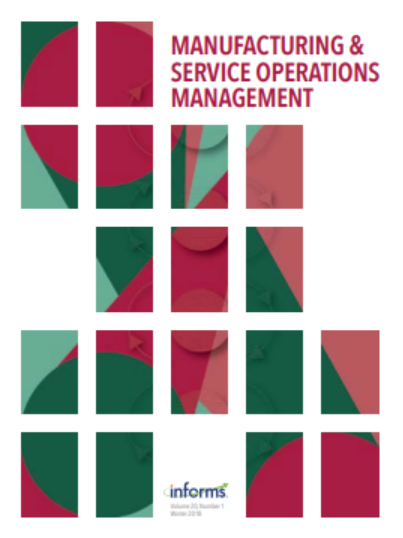An Analysis of Incentive Schemes for Participant Retention in Clinical Studies
IF 4.8
3区 管理学
Q1 MANAGEMENT
M&som-Manufacturing & Service Operations Management
Pub Date : 2023-05-01
DOI:10.1287/msom.2022.1184
引用次数: 1
Abstract
Problem definition: Participant retention is one of the significant issues faced by clinical studies. This paper analyzes the economic impact of combining two mechanisms (monetary payments to participants and effort exerted during a clinical study) observed in practice to improve retention. Methodology/results: Given an incentive scheme, under full information and information asymmetry regarding participants’ characteristics, we model the problem of identifying optimal payment and effort to improve retention for a clinical study using a nonlinear integer program. We propose polynomial-time algorithms to solve the problem under full information for a participant-specific linear payment scheme and two commonly observed incentive schemes: Fixed Payment (FP) and Logistics Reimbursement (RE). We also provide exact methods to solve the problem under information asymmetry for the FP and RE schemes. We conduct a comprehensive computational study to gain insights into the relative performance of these schemes. Under full information, the participant-specific scheme can reduce the retention cost by about 46%, on average, compared with that under the RE and FP schemes. Information asymmetry causes the RE scheme to be more favorable than the FP scheme in a wider variety of clinical studies. Further, the value of acquiring participants’ characteristics information is significant under the FP scheme compared with that under the RE scheme. Managerial implications: The determination of monetary payments is ad hoc in practice. Further, an economic analysis of the two mechanisms for improving retention in clinical studies is absent. Given the participants and the clinical study characteristics under full information and information asymmetry, our analysis enables a decision maker to identify an optimum incentive scheme, monetary payment, and effort level for improving retention. Further, our analysis allows a clinical study decision maker to assess budget requirements to improve retention and adapt the incentive payments to Institutional Review Board guidelines, if any. Supplemental Material: The online appendix is available at https://doi.org/10.1287/msom.2022.1184 .临床研究中参与者保留的激励机制分析
问题定义:受试者保留是临床研究面临的重要问题之一。本文分析了在实践中观察到的两种机制(向参与者支付货币和在临床研究中付出的努力)相结合对提高保留率的经济影响。方法/结果:给定一个激励方案,在关于参与者特征的充分信息和信息不对称的情况下,我们使用非线性整数程序对临床研究中确定最佳支付和努力以提高保留率的问题进行建模。我们提出了多项式时间算法来解决参与者特定的线性支付方案和两种常见的激励方案:固定支付(FP)和物流报销(RE)的充分信息下的问题。我们还给出了FP和RE方案在信息不对称情况下的精确求解方法。我们进行了全面的计算研究,以深入了解这些方案的相对性能。在充分信息条件下,与可再生资源和计划生育方案相比,参与者特定方案平均可降低约46%的保留成本。信息不对称导致RE方案在更广泛的临床研究中比FP方案更有利。此外,与RE方案相比,FP方案获取参与者特征信息的价值显著。管理影响:货币支付的确定在实践中是临时的。此外,在临床研究中,缺乏对两种改善留置机制的经济分析。在充分信息和信息不对称的情况下,我们的分析使决策者能够确定最佳的激励方案、货币支付和努力水平,以提高保留率。此外,我们的分析允许临床研究决策者评估预算需求,以提高保留率,并根据机构审查委员会的指导方针(如果有的话)调整激励支付。补充材料:在线附录可在https://doi.org/10.1287/msom.2022.1184上获得。
本文章由计算机程序翻译,如有差异,请以英文原文为准。
求助全文
约1分钟内获得全文
求助全文
来源期刊

M&som-Manufacturing & Service Operations Management
管理科学-运筹学与管理科学
CiteScore
9.30
自引率
12.70%
发文量
184
审稿时长
12 months
期刊介绍:
M&SOM is the INFORMS journal for operations management. The purpose of the journal is to publish high-impact manuscripts that report relevant research on important problems in operations management (OM). The field of OM is the study of the innovative or traditional processes for the design, procurement, production, delivery, and recovery of goods and services. OM research entails the control, planning, design, and improvement of these processes. This research can be prescriptive, descriptive, or predictive; however, the intent of the research is ultimately to develop some form of enduring knowledge that can lead to more efficient or effective processes for the creation and delivery of goods and services.
M&SOM encourages a variety of methodological approaches to OM research; papers may be theoretical or empirical, analytical or computational, and may be based on a range of established research disciplines. M&SOM encourages contributions in OM across the full spectrum of decision making: strategic, tactical, and operational. Furthermore, the journal supports research that examines pertinent issues at the interfaces between OM and other functional areas.
 求助内容:
求助内容: 应助结果提醒方式:
应助结果提醒方式:


